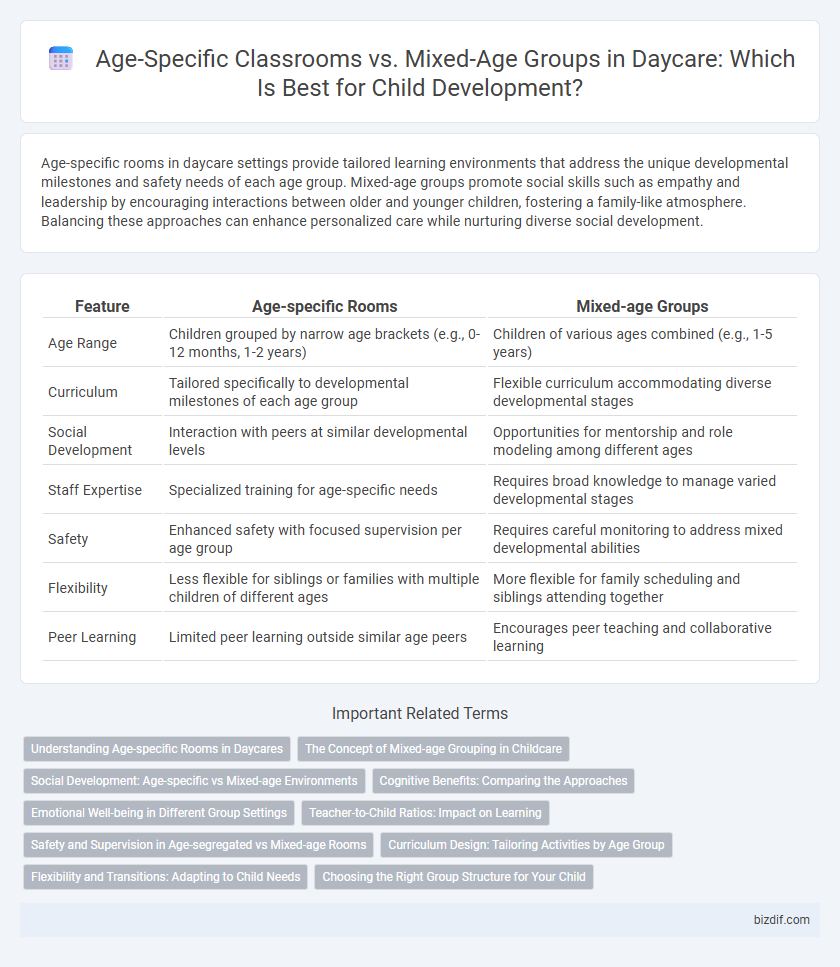Age-specific rooms in daycare settings provide tailored learning environments that address the unique developmental milestones and safety needs of each age group. Mixed-age groups promote social skills such as empathy and leadership by encouraging interactions between older and younger children, fostering a family-like atmosphere. Balancing these approaches can enhance personalized care while nurturing diverse social development.
Table of Comparison
| Feature | Age-specific Rooms | Mixed-age Groups |
|---|---|---|
| Age Range | Children grouped by narrow age brackets (e.g., 0-12 months, 1-2 years) | Children of various ages combined (e.g., 1-5 years) |
| Curriculum | Tailored specifically to developmental milestones of each age group | Flexible curriculum accommodating diverse developmental stages |
| Social Development | Interaction with peers at similar developmental levels | Opportunities for mentorship and role modeling among different ages |
| Staff Expertise | Specialized training for age-specific needs | Requires broad knowledge to manage varied developmental stages |
| Safety | Enhanced safety with focused supervision per age group | Requires careful monitoring to address mixed developmental abilities |
| Flexibility | Less flexible for siblings or families with multiple children of different ages | More flexible for family scheduling and siblings attending together |
| Peer Learning | Limited peer learning outside similar age peers | Encourages peer teaching and collaborative learning |
Understanding Age-specific Rooms in Daycares
Age-specific rooms in daycares provide tailored environments that cater to the developmental needs of children at similar stages, such as infants, toddlers, or preschoolers, ensuring age-appropriate activities and safety measures. These dedicated spaces support targeted learning objectives, including motor skills development for toddlers and cognitive growth for preschoolers, enhancing individualized care quality. Grouping children by age also allows caregivers to specialize in specific developmental milestones, improving supervision and fostering social interactions within peer groups.
The Concept of Mixed-age Grouping in Childcare
Mixed-age grouping in childcare fosters social development by encouraging children to interact with peers of varying ages, promoting empathy, leadership, and conflict resolution skills. It supports individualized learning pace as educators tailor activities to accommodate diverse developmental stages within a single room. This approach enhances adaptability and peer learning, preparing children for real-world social environments beyond age-segregated settings.
Social Development: Age-specific vs Mixed-age Environments
Age-specific rooms in daycare settings foster social development by allowing children to interact with peers at similar developmental stages, promoting age-appropriate communication and play skills. Mixed-age groups encourage mentorship and empathy as older children model behavior and assist younger peers, enhancing social adaptability and cooperative learning. Both environments offer unique benefits that support various aspects of social growth, depending on the individual needs and dynamics of the children involved.
Cognitive Benefits: Comparing the Approaches
Age-specific rooms in daycare provide tailored cognitive stimulation that aligns with developmental milestones, enhancing skill acquisition in focused domains such as language or motor skills. Mixed-age groups promote cognitive flexibility and social learning by encouraging older children to mentor younger peers, fostering problem-solving and empathy. Research indicates that combining both approaches can optimize cognitive benefits by balancing specialized instruction with peer-driven learning opportunities.
Emotional Well-being in Different Group Settings
Age-specific rooms promote emotional well-being by providing children with peers at similar developmental stages, fostering a sense of belonging and reducing social anxiety. Mixed-age groups enhance emotional growth by encouraging empathy, cooperation, and mentorship opportunities between older and younger children. Both settings impact emotional well-being differently, with age-specific rooms offering tailored social interaction and mixed groups supporting diverse social skills development.
Teacher-to-Child Ratios: Impact on Learning
Age-specific rooms in daycare centers typically maintain lower teacher-to-child ratios, enhancing individualized attention and tailored learning experiences critical for developmental milestones. Mixed-age groups often have higher ratios, which can limit personalized interactions but foster peer learning and social skills through diverse age dynamics. Optimal teacher-to-child ratios directly impact the quality of cognitive, emotional, and social growth, making ratio management vital for effective early childhood education outcomes.
Safety and Supervision in Age-segregated vs Mixed-age Rooms
Age-specific rooms enhance safety by tailoring environments and supervision to developmental stages, reducing risks such as choking hazards or aggressive behaviors common in mixed-age groups. Children benefit from caregivers trained to address specific age-related needs, enabling more effective monitoring and immediate response to age-typical challenges. In contrast, mixed-age groups may increase supervision complexity as staff must manage diverse physical abilities and social dynamics, potentially impacting overall safety.
Curriculum Design: Tailoring Activities by Age Group
Age-specific rooms enable precise curriculum design by targeting developmental milestones unique to each age group, enhancing cognitive and motor skill growth. Mixed-age groups promote social learning and mentorship opportunities but require adaptable activities that balance diverse developmental stages. Tailoring activities based on age-specific needs improves engagement and fosters age-appropriate learning outcomes.
Flexibility and Transitions: Adapting to Child Needs
Age-specific rooms in daycare centers provide structured environments tailored to developmental stages, enhancing targeted learning and socialization. Mixed-age groups promote flexibility by allowing children to transition naturally as they develop, fostering peer mentorship and adaptable social skills. Balancing these approaches supports individual child needs, ensuring smoother progress through developmental milestones and personalized care during transitions.
Choosing the Right Group Structure for Your Child
Selecting the appropriate group structure in daycare significantly impacts a child's development, with age-specific rooms offering targeted curricula tailored to developmental milestones for infants, toddlers, or preschoolers. Mixed-age groups promote social skills and empathy as children learn from peers at various stages, fostering collaboration and leadership opportunities. Parents should consider their child's temperament, social needs, and learning style when choosing between structured age groups and dynamic mixed-age environments to ensure optimal growth and comfort.
Age-specific Rooms vs Mixed-age Groups Infographic

 bizdif.com
bizdif.com